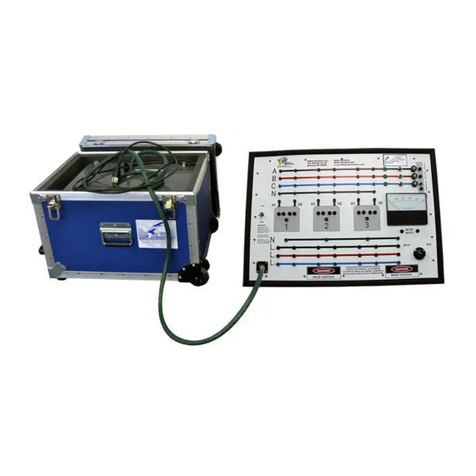
8
C-00847 XFMR-4BUSHING
(5-25-16)
Operation
The Load-Trainer Transformer Simulator has the capability to connect single-phase and the following
types of three-phase transformers:
Simple Single-Phase Transformer Connections
1. The system should be OFF and remain OFF except for observing voltage measurements on the AC
meter for short periods of time.
2. Be sure all 8 Toggle Switches are in the UP position for normal operation. Be sure all 3 Disconnecting
Switches are ‘ON’ and reset any tripped Circuit Breakers.
3. Using the red ‘pin’ tip patch cords connect a single-phase transformer to a DELTA system primary
as shown in Example 1.
4. Set rheostat pointer to ‘DELTA’.
5. Make output connections with the red and black banana patch cords bringing leads down to load
lines to a 120 Volt WYE secondary as shown in Example 1.
6. Turn the unit ON. The Power Supply will start and deliver the proper voltage to the transformer.
NOTE: The power unit should not be operated for extended periods of time. Run only when
taking voltage readings.
7. If connections have been properly made voltage should appear on the AC Meter. These readings
should be near normal for the transformer bank being made. Use the rheostat to make minor
adjustments.
8. Problems can be introduced after the installation has been shown to operate correctly. This is
done by the toggle switches on the left side of the Front Panel (see Figure 1) and at the instructors
discretion to simulate real world scenarios.
NOTE:
In certain congurations the actual measured device output voltage is greater than or less than the
expected voltage for a given simulation. The AC Meter has been scaled at the factory to compensate for
the differing output voltages. An independent meter device may display voltages that are not expected.
Delta-Delta
Delta-Wye
Open Delta-Open Delta
Wye-Delta
Wye-Wye
Wye (one leg out)-Open Delta
Examples
The following table summarizes the Connection Diagrams provided on the following pages:
Example Simulation
1 Single Phase Transformer w/ Delta Primary & 120 Volt Wye Secondary
2 Single Phase Transformer w/ Delta Primary & 120 Volt Delta Secondary
3 Single Phase Transformer w/ Delta Primary & 120/ 240 Volt Delta Secondary
4 Three Phase Transformer w/ Delta Primary & 120 / 208 Volt Wye Secondary
5 Three Phase Transformer w/ Delta Primary & 120 Volt Delta Secondary
6 Three Phase Transformer w/ Delta Primary & 120 / 240 Volt High Leg B Delta Secondary
7 Three Phase Transformer w/ Open Delta Primary & 120 Volt Open Delta Secondary
8 Three Phase Transformer w/ Wye Primary & 120 Volt Delta Secondary
9 Three Phase Transformer w/ Wye Primary & 120 / 208 Volt Wye Secondary
10 Three Phase Transformer w/ Wye (One Leg Out) & 120 Volt Open Delta Secondary




























